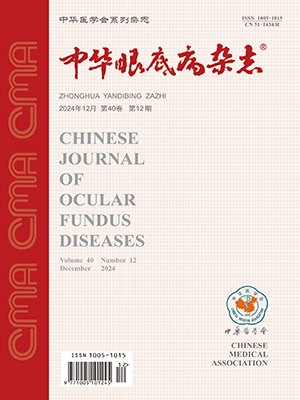| 1. |
Jarius S, Ruprecht K, Wildemann B, et al. Contrasting disease patterns in seropositive and seronegative neuromyelitis optica: a multicentre study of 175 patients[J]. J Neuroinflammation, 2012, 9:14. DOI:10.1186/1742-2094-9-14.
|
| 2. |
Lennon VA, Wingerchuk DM, Kryzer TJ, et al. A serum autoantibody marker of neuromyelitis optica: distinction from multiple sclerosis[J]. Lancet, 2004,364(9451):2106-2112.DOI: 10.1016/S0140-6736(04)17551-X.
|
| 3. |
Lennon VA, Kryzer TJ, Pittock SJ, et al. IgG marker of optic-spinal multiple sclerosis binds to the aquaporin-4 water channel[J]. J Exp Med, 2005,202(4):473-477.
|
| 4. |
Wingerchuk DM, Lennon VA, Pittock SJ, et al. Revised diagnostic criteria for neuromyelitis optica[J]. Neurology, 2006, 66(10):1485-1489. DOI: 10.1212/01.wnl.0000216139.44259.74.
|
| 5. |
Papadopoulos MC, Verkman AS. Aquaporin 4 and neuromyelitis optica[J]. Lancet Neurol, 2012, 11(6): 535-544. DOI:10.1016/S1474-4422(12)70133-3.
|
| 6. |
McKeon A, Fryer JP, Apiwattanakul M, et al. Diagnosis of neuromyelitis spectrum disorders: comparative sensitivities and specificities of immunohistochemical and immunoprecipitation assays[J]. Arch Neurol, 2009, 66(9):1134-1138. DOI: 10.1001/archneurol.2009.178.
|
| 7. |
Jarius S, Frederikson J, Waters P, et al. Frequency and prognostic impact of antibodies to aquaporin-4 in patients with optic neuritis[J].J Neurol Sei, 2010, 298(1-2):158-162. DOI: 10.1016/j.jns.2010.07.011.
|
| 8. |
Wingerchuk DM, Hogancamp WF, O'Brien PC, et al. The clinical course of neuromyelitis optica (Devic's syndrome)[J].Neurology,1999, 53(5):1107-1114.
|
| 9. |
Pirko I, Blauwet LA, Lesnick TG, et al. The natural history of recurrent optic neuritis[J]. Arch Neurol, 2004, 61(9):1401-1405. DOI:10.1001/archneur.61.9.1401.
|
| 10. |
Keltner JL, Johnson CA, Spurr JO, et al. Baseline visual field profile of optic neuritis:the experience of the optic neuritis treatment trial[J].Arch Ophthalmol, 1993, 111(2):231-234.
|
| 11. |
Hickman SJ, Ko M, Chaudhry F, et al. Optic neuritis: an update typical and atypical optic neuritis[J]. Neuro-Ophthalmol, 2008,32(5):237-248.
|
| 12. |
Shams PN, Plant GT. Optic neuritis: a review[J]. Int MS J, 2009, 16(3):82-89.
|
| 13. |
Pau D, Al Zubidi N, Yalamanchili S, et al. Optic neuritis[J]. Eye, 2011, 25(7):833-842. DOI: 10.1038/eye.2011.81.
|
| 14. |
Wingerchuk DM, Banwell B, Bennett JL, et al.International consensus diagnostic criteria for neuromyelitis optica spectrum disorders[J].Neurology, 2015,85(2):177-189. DOI: 10.1212/WNL.0000000000001729.
|
| 15. |
Matiello M, Lennon VA, Jacob A, et al. NMO-IgG predicts the outcome of recurrent optic neuritis[J]. Neurology, 2008, 70(23):2197-2200. DOI: 10.1212/01.wnl.0000303817.82134.da.
|
| 16. |
Chan KH, Ramsden DB, Yu YL, et al. Neuromyelitis optica-IgG in idiopathic inflammatory demyelinating disorders amongst Hong Kong Chinese[J]. Eur J Neurol, 2009, 16(3):310-316. DOI: 10.1111/j.1468-1331.2008.02376.x.
|
| 17. |
Pittock SJ, Lennon VA, de Seze J, et al. Neuromyelitis optica and non organ-specific autoimmunity[J]. Arch Neurol, 2008, 65(1):78-83. DOI: 10.1001/archneurol.2007.17.
|
| 18. |
Wingerchuk DM, Weinshenker BG. The emerging relationship between neuromyelitis optica and systemic rheumatologic autoimmune disease[J].Mult Scler, 2012, 18(1):5-10. DOI: 10.1177/1352458511431077.
|
| 19. |
Dale RC, Tantsis EM, Merheb V, et al. Antibodies to MOG have a demyelination phenotype and affect oligodendrocyte cytoskeleton[J/OL]. Neurol Neuroimmunol Neuroinflamm, 2014, 1(1):12[2014-05-22]. http://europepmc.org/abstract/MED/25340056. DOI:10.1016/J.Jneuroim.2014.08.049.
|
| 20. |
Rostasy K, Mader S, Hennes EM, et al. Persisting myelin oligodendrocyte glycoprotein, antibodies in aquaporin-4 antibody negative pediatric neuromyelitis optica[J]. Mult Scler, 2013,19(8):1052-1059. DOI: 10.1177/1352458512470310.
|




